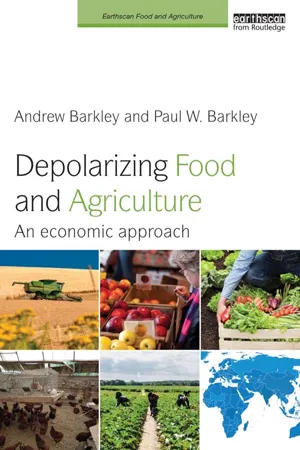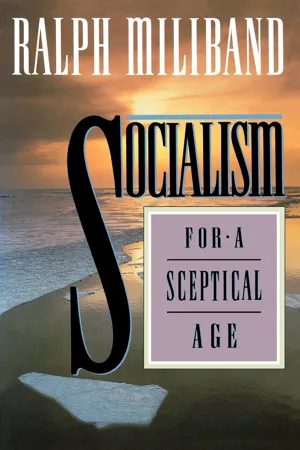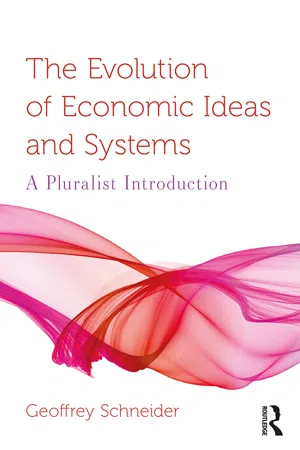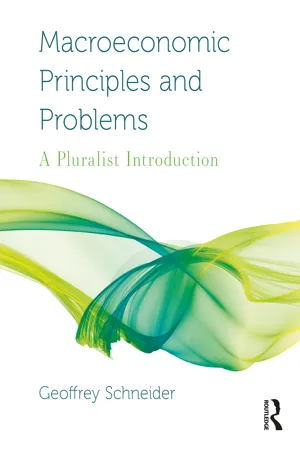Economics
Mixed Economy
A mixed economy is an economic system that combines elements of both capitalism and socialism. In a mixed economy, the government and the private sector coexist, with the government playing a role in regulating and providing certain goods and services, while allowing for private enterprise and market forces to operate. This system aims to balance individual freedom and social welfare.
Written by Perlego with AI-assistance
Related key terms
Related key terms
1 of 4
Related key terms
1 of 3
6 Key excerpts on "Mixed Economy"
- eBook - ePub
Depolarizing Food and Agriculture
An Economic Approach
- Andrew Barkley, Paul W. Barkley(Authors)
- 2014(Publication Date)
- Routledge(Publisher)
Today’s industrial agriculture has followed a similar path by adding inputs such as chemicals, fertilizer, and machinery. These inputs to food production are generally produced by large corporations and sold to farmers and ranchers who, in turn, provide raw foods to processors, often large food corporations such as Kraft, ConAgra, or Beatrice. Retailers and distributors complete the circular flow through specialized and concentrated supermarket chains: Kroger, Safeway, and Walmart, who sell daily food needs to consumers. Different nations and different cultures organize their economy in different ways. We will explore these differences in the next section.Market economies, command economies, and mixed economiesA “market economy” is an economy characterized by market interactions where resources and goods are allocated by prices. In contrast, a “command economy” is defined as an economy characterized by command and control, in which resources are allocated by whoever is in charge, whether it be a dictator, or a committee of appointed experts, or democratically elected officials. The characteristics of each of these two extreme cases of economic organization are explored below. In reality, the two polar cases are hypothetical, since market-based economies have high levels of government involvement, and command economies have many features of market systems. Thus, as a practical matter, all real-world economic systems are “mixed economies,” that combine features of markets and government regulation and services. Large potential societal gains come from markets (high incomes and economic growth), as do costs of disruption, change, and income inequality (Piketty and Goldhammer, 2014). The benefits of markets come at a cost, and the costs lead to polarization of views and opinions on political and economic issues. The weaknesses and limitations of markets are presented and evaluated in later chapters of the book.Market economies and consumer sovereignty“Consumer sovereignty” is the foundation of market systems since consumer preferences determine the production of goods and services. The firms that do the best job of providing what consumers desire will be the most successful. Producers, firms, and distribution networks all respond to consumer wants and desires. Moreover, in a market economy, producers’ activities must remain consistent with consumer demands (or desires), or firms will face going out of business. It is often argued that big firms such as Microsoft, Walmart, and McDonald’s are bad for the economy and bad for consumers. In many ways, this is not the case in a competitive market economy with many choices of where to shop. The firms that earn the largest revenues from product sales provide evidence that consumers desire products from these large producers and sellers. While it is true that organizational and administrative problems may exist within each of these huge firms, just as they exist in firms of all sizes, it remains true that the firms must be doing something right, or they would not sell so much software, groceries and household goods, hamburgers, fries, and other products. In many cases, the most profitable firms are the ones that are most successful at dealing with market changes. - eBook - ePub
Pluralism and Corporatism
The Political Evolution of Modern Democracies
- Reginald J. Harrison(Author)
- 2019(Publication Date)
- Routledge(Publisher)
What the historical record shows is that questions about the distribution of material goods cannot be considered entirely apart from the economic activity which engenders them, as though they were a kind of consequent but separate ethical problem. Capitalism as an economic system connotes certain assumptions about economic distribution. It assumes that the possession and use of productive resources – land, capital, energy, talents – will bring differential rewards to the degree that they are needed in the market-place. Though all society benefits from the stimulus which economic incentives provide to an expansion of productive activity, any notions of justice in the sense of ‘fair shares’ or ‘equality’ are out of place. In terms of social values achieved, liberty’, loosely conceived, stands higher than ‘equality’, its historical societal rival. Centrally planned economic systems, on the other hand, have to face directly the ethical aspects of economic distribution as they relate to the governmentally defined overall goals and to ideologically based definitions of the ‘common good’. The development of the ‘Mixed Economy’ with its element of central planning presents, increasingly, the same ethical problem.In practice, perhaps needless to say, there never have been ‘pure’ versions of the two kinds of economic system. Compassion, notions of justice and the pressures of powerful economic interests on government have modified a simple market distribution of resources (though not always in the direction of equality),5 and in central economic planning in Eastern Europe ideas of distributive justice are muddied in practice by strategic, incentive considerations in the pursuit of immediate economic growth targets. But the development of the Mixed Economy of the advanced industrial societies and the planning role of the state which it subsumes, brings the rivalry between liberty and equality to the forefront of political dispute. Different, albeit vaguely - eBook - ePub
- (Author)
- 2014(Publication Date)
- KW Publishers(Publisher)
4 A Mixed Economy’s Endeavour for Growth Without DependenceTHE INDIAN ECONOMY, for the past three decades (19650’s to 1980)has been subjected to a continuous process of planned restructuring under central direction. An interesting consequence of this effort has been the increasing infusion of a national political vision into the economic order. This progressive politicization of the economy is, however, only superficially comparable to a similar process in the modern variant of the market economy.1 The latter, while receiving measured doses of state regulation in exchange of the legal support it needs and receives for its long term operation can also manage to exert an occasional back-lash on the state authorities through its own political support structure across the social spectrum.This spectacle, much as it is attractive to the barons of private business in India , generally appears in a subdued from because of the Mixed Economy arrangement. Under this set-up the major macro- economic decisions such as allocation of scarce and strategic resources, choice of sectors for massive planned investment, pattern of technology assimilation and, above all ,the inflow and outflow of resources across other countries are mostly taken care of by the State and therefore, largely subject to the political perceptions of those who are in power. In this sense economic planning may be viewed as a necessary extension of national politics.As discussed earlier, one of the preoccupations of planning in India relates to the question of dependence and its successful reversal. The terms in which dependency, actual or apprehended, is conceived relate primarily to the threat perception of the national elite. While these threat perceptions get articulated through public agencies full play is given to economic nationalism so that all the vital sectors of the economy are put on alert and unite in their efforts to offer an effective resistance. In building up this resistance the public authorities have to count upon the support of the business community whose response, in turn, would depend not only upon its own appreciation of the situation but also upon its habitual relations with the wielders of political power. - eBook - ePub
- Ralph Miliband(Author)
- 2020(Publication Date)
- Verso(Publisher)
4The Mixed Economy,Socialist Style
1
In the economic realm as elsewhere, socialist democracy represents both an extension of capitalist democracy, and a transcendence of it.State intervention in the economy is the best example of what this means. The fashion in recent years has been to denigrate state intervention and to exalt the virtues of the market. Yet one of the most notable features of the history of capitalism from its beginnings right up to the present day has been its reliance on the state and its dependence upon it.For the state is, by its very nature, inevitably involved in ‘economic life’ by virtue of the budgetary and taxation policies which it alone can promulgate and implement. But state intervention goes far beyond this. For it is the state, even in the regimes most dedicated to ‘free enterprise’, which provides capitalism with protection and help, not only in political, legal, police and military terms, but also in strictly economic terms as well, by way of subsidies, allowances, tariffs, concessions, contracts, rescue of failing banks and other enterprises, protection from foreign competition, and a host of other measures designed to help capitalist enterprise. So too has the state had to intervene in economic life in order to protect society from the depredations wrought by a capitalism which cannot afford to be unduly concerned with the individual and social costs generated by the logic of the system. Governments have had to save capitalism from itself, and to deploy on its behalf a consciousness which, left alone, it has been unable to develop in relation to what is required for its preservation and strengthening. In short, the survival of the system has always depended on government intervention in the economy; and it is worth stressing how much, as a system of domination and exploitation, it has depended on the coercive power of the state. - eBook - ePub
The Evolution of Economic Ideas and Systems
A Pluralist Introduction
- Geoffrey Schneider(Author)
- 2018(Publication Date)
- Routledge(Publisher)
They prefer democratic socialism, an economic system in which the most important resources of society are controlled democratically by all citizens, including workers who usually have little say in how market capitalist economies are run. From this perspective, markets are not particularly efficient, as they produce wasteful and unnecessary goods while neglecting other, more important things such as public health, leisure time with one’s family, workers’ quality of life, and the environment. Depending on which economists have the most influence and the economic views of politicians, the economic systems of countries around the globe exhibit substantial variations. Almost all modern economies can be classified as mixed market capitalist, in that they depend on markets for the production and distribution of most goods and services, but they also utilize a substantial degree of government intervention. As you can see from Figure 1.5, which depicts the size of the government sector in selected economies around the world, the U.S. has the smallest government of any developed economy, coming the closest to unregulated market capitalism. One of the reasons for this is that the U.S. is the only developed economy without a national health care system. Even very market-oriented countries like the United Kingdom (U.K.) and Australia provide national health care to all citizens - eBook - ePub
Macroeconomic Principles and Problems
A Pluralist Introduction
- Geoffrey Schneider(Author)
- 2022(Publication Date)
- Routledge(Publisher)
They prefer strictly regulated capitalism. Radical economists go even further, preferring democratic socialism, an economic system in which the most important resources of society are controlled democratically by all citizens, including workers, who usually have little say in how market capitalist economies are run. From this perspective, markets are not particularly efficient, because they produce wasteful and unnecessary goods while neglecting other, more important things such as public health, leisure time with one’s family, workers’ quality of life, and the environment. Depending on which economists have the most influence and the economic views of politicians, the economic systems of countries around the globe exhibit substantial variations. Almost all modern economies can be classified as mixed market capitalist, in that they depend on markets for the production and distribution of most goods and services but they also utilize a substantial degree of government intervention. As you can see from Figure 1.5 on the next page, which depicts the size of the government sector in selected economies around the world, the United States has the smallest government of any developed economy, coming the closest to unregulated market capitalism. One of the reasons for this is that the United States is the only developed economy without a national health care system. Even very market-oriented countries like the United Kingdom and Australia provide national health care to all citizens
Index pages curate the most relevant extracts from our library of academic textbooks. They’ve been created using an in-house natural language model (NLM), each adding context and meaning to key research topics.
Explore more topic indexes
Explore more topic indexes
1 of 6
Explore more topic indexes
1 of 4





